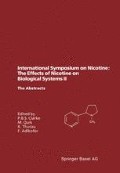Abstract
Molecular cloning studies have demonstrated structural and functional diversity in neuronal nicotinic acetylcholine receptors. To date, seven a subunits (a2 to a8) and three α subunits (α2 to α4) have been characterised in the nervous system of vertebrates. We now report the identification and functional characterization of a new member of this family of receptor subunit genes: α9. A full-length cDNA clone encoding a protein of 480 amino acids was isolated from an olfactory epithelium library. The deduced amino acid sequence reveals that a9 has significant homology with other nicotinic acetylcholine receptor a subunits. In situ hybridization studies using sagittal sections of rat embryos show that this subunit is expressed in the olfactory epithelium and in the pars tuberalis of the pituitary. In vitro transcribed a9 cRNA injected into Xenopus laevis oocytes results in the formation of a homomeric, cationic channel which is activated by acetylcholine with an EC50 of 10µM. While acetylcholine is a full agonist, both the nicotinic agonist DMPP and the muscarinic agonist oxotremorine-M are weak partial agonists. The receptor is not activated either by nicotine or by muscarine. However, both nicotine and muscarine behave as competitive antagonists with an IC50 at 10µM acetylcholine of 45 µM and 84 µM, respectively. Classical nicotinic (d-tubocurarine, ßerythroidine) and muscarinic (atropine) antagonists also block the responses elicited by acetylcholine. Both a-bungarotoxin (100nM) and κ-bungarotoxin (100nM) block the recombinant receptor in a reversible manner. In summary, these heterologous expression studies show that the receptor-channel complex formed with a9 has a mixed nicotinicmuscarinic pharmacology. In vivo receptors with similar properties have been reported in cochlear hair cells of chick and rat (Fuchs and Murrow, Proc. R. Soc. Lond. B. 248: 35, 1992; Housley and Ashmore, Proc. R. Soc. Lond. B. 244: 161, 1991). PCR experiments using specific primers for α9 and cDNA reverse transcribed from rat cochlear total RNA show that this subunit gene is transcribed in this tissue.
Access this chapter
Tax calculation will be finalised at checkout
Purchases are for personal use only
Preview
Unable to display preview. Download preview PDF.
Author information
Authors and Affiliations
Editor information
Editors and Affiliations
Rights and permissions
Copyright information
© 1994 Springer Basel AG
About this chapter
Cite this chapter
Elgoyhen, A.B. et al. (1994). Receptor subtypes — Molecular biology and pharmacology. In: Clarke, P.B.S., Quik, M., Thurau, K., Adlkofer, F. (eds) International Symposium on Nicotine: The Effects of Nicotine on Biological Systems II. Experientia Supplementum, vol 71. Birkhäuser, Basel. https://doi.org/10.1007/978-3-0348-7416-8_8
Download citation
DOI: https://doi.org/10.1007/978-3-0348-7416-8_8
Publisher Name: Birkhäuser, Basel
Print ISBN: 978-3-7643-5087-1
Online ISBN: 978-3-0348-7416-8
eBook Packages: Springer Book Archive

